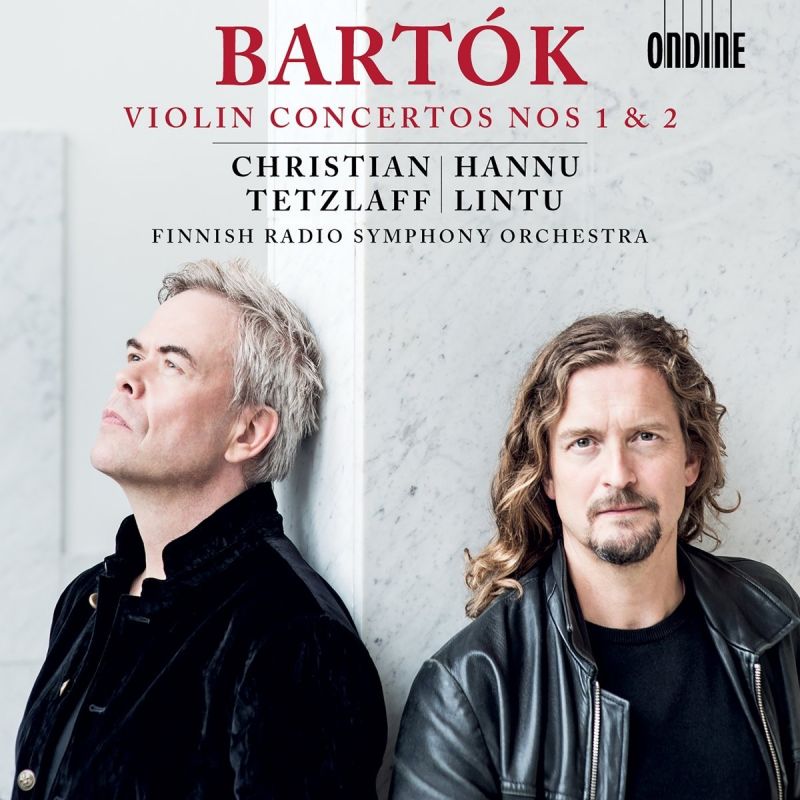BARTÓK Violin Concertos Nos 1 & 2 (Tetzlaff)
View record and artist detailsRecord and Artist Details
Composer or Director: Béla Bartók
Genre:
Orchestral
Label: Ondine
Magazine Review Date: 05/2018
Media Format: CD or Download
Media Runtime: 61
Mastering:
DDD
Catalogue Number: ODE1317-2

Tracks:
| Composition | Artist Credit |
|---|---|
| Concerto for Violin and Orchestra No. 1 |
Béla Bartók, Composer
Béla Bartók, Composer Christian Tetzlaff, Violin Finnish Radio Symphony Orchestra Hannu Lintu, Conductor |
| Concerto for Violin and Orchestra No. 2 |
Béla Bartók, Composer
Béla Bartók, Composer Christian Tetzlaff, Violin Finnish Radio Symphony Orchestra Hannu Lintu, Conductor |
Author: Rob Cowan
Ondine’s new Bartók CD is an out-and-out winner; but, having in the past praised numerous versions of these two works, I feel it only fair to open this review by placing Christian Tetzlaff and Hannu Lintu in a proper critical context.
Viewed at a realistic perspective, when it comes to coupling Bartók’s two violin concertos on the same CD there are six principal digital contenders. James Ehnes stands apart in that he adds the Viola Concerto, a bonus that in musical terms is very much to be reckoned with. His performances are warmly communicative and much aided by vivid support from the BBC Philharmonic under Gianandrea Noseda. So if you want all three works very persuasively performed, and the three-tier concerto context appeals, then there’s no contest: it has to be Ehnes.
Where Ehnes takes a sweetly romantic view of the First Concerto’s amatory first movement, Renaud Capuçon is more soulfully romantic, even doleful at times. But he also does well by both concertos. So too do Arabella Steinbacher and Marek Janowski: when reviewing their CD in these pages I commented how they ‘offer us Bartók in 3D, the three dimensions not only spatial but emotional as well. I can’t think of a version of the Second Concerto, past or present, where structure and content are more thoughtfully balanced, or where significant points in the score are more lovingly underlined.’ I stand by that assessment but, when it comes to structure and content being thoughtfully balanced, they now have a formidable rival in Tetzlaff and Lintu. That’s not forgetting Isabelle Faust and Daniel Harding, who provide a lean, lissom and sensitively phrased option, nor Thomas Zehetmair with Iván Fischer, who are probably closest in style to the current CD under review. And of course Patricia Kopatchinskaja’s Second Concerto (2013 Gramophone Recording of the Year, coupled with works by Eötvos and Ligeti) is chock-full of character – a real one-off.
So what makes this new release so special? Bartók’s brilliantly scored Second Concerto in particular is a blend of earth and spirit, formal sophistication and phantasmagorical invention, folk-like themes and harmonic originality. These elements are securely focused by Tetzlaff and Lintu in the second movement especially, where, to call on a nature metaphor, the music suggests an exquisitely coloured hummingbird: such fragile beauty in the quieter episodes, sometimes reduced to a mere whisper (from 6'11" is pure filigree), Lintu always cueing a fine-spun accompaniment; though when the going gets tough (at 4'39" into the same movement), where wind and timps loudly protest against the carping soloist, the effect is dramatic. In the movement’s central scherzo episode, from 7'16", with its tremulously dialoguing violin and percussion (fast whirring of wings?), you can almost feel the music’s physical impact.
The outer movements are superb, Tetzlaff pressing forwards or cosseting the line according to the dictates of the moment. But always there’s that awareness of a master colourist in the forefront; nothing is ever showy just for the sake of it, yet at 7'15" into the first movement, after Tetzlaff has reduced his tone to something barely audible, he rudely breaks the mood with a virtuoso flourish. Between them Tetzlaff and Lintu command a compelling and comprehensive overview of this multifaceted masterpiece, its fierce rhythms and many moments of affecting repose, not to mention its very singular emotional climate. Incidentally, Bartók’s original, purely orchestral ending is used. I much prefer it.
The First Concerto is equally fine, at the very least. Listen from 7'07" into the Allegro giocoso second movement, a dizzying sequence of repeated phrases from Christian Tetzlaff tailed by an exultant tutti where Lintu and his Finnish Radio players bound in like excited kids in a playground. It’s a wonderful, conspicuously Straussian moment which I often revisit on my old Isaac Stern/Eugene Ormandy recording – but Tetzlaff and Lintu are in a different league. The same is true of the whole concerto, in fact, Tetztlaff commanding a wider range of tonal colours for the opening section of the preceding Andante sostenuto than almost anyone else on disc. To call on another nature metaphor, this is flora and fauna translated in terms of sound; and as the movement progresses, so the emotional tension builds commensurately.
I’ve said it before, but my favoured couplings for the Second Concerto are the two magnificent Rhapsodies (as played by Barnabás Kelemen under Zoltán Kocsis on Hungaroton, who also add variant versions). But Tetzlaff’s account of the First Concerto elevates this work to a whole new level of musical excellence, so much so that I’m inclined to place his expertly recorded CD of the two concertos ahead of all rival versions. It’s that good!
Discover the world's largest classical music catalogue with Presto Music.

Gramophone Digital Club
- Digital Edition
- Digital Archive
- Reviews Database
- Full website access
From £8.75 / month
Subscribe
Gramophone Full Club
- Print Edition
- Digital Edition
- Digital Archive
- Reviews Database
- Full website access
From £11.00 / month
Subscribe
If you are a library, university or other organisation that would be interested in an institutional subscription to Gramophone please click here for further information.




